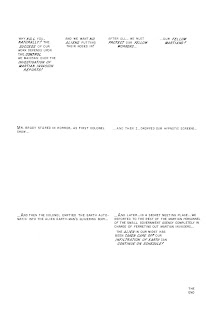
A couple of people -- including myself -- pointed out that, in this case, the text and the word balloons themselves are acting as art. However, I'll also point out that it's not impossible to come up with a solid example of a comic that would read reasonably well without the art. Here's a random page from Shock Suspenstories #7...

And here's the same page without the art...

Even without the sound effects, and the fact that we're jumping into the middle of a story, it still seems to make perfect sense to me. Conversely, though, here's an example of a comic page with the text and word balloons removed...

It's from Scott McCloud's Understanding Comics and in this sequence, he's discussing nuances of language and imagry. Becuase of the specific nature of what McCloud was trying to do here, we have effectively the same image repeated six times. (Ten times, actually, since the previous page in the book has four more copies of the same panel.) But without the text, does this tell you anything? We see a man standing in front of a painting. He moves his arms a bit, but I don't know that that really conveys a story of any sort.
Or what about a sequence whose narrative is entirely disconnected with the imagry depicted? I can't seem to find a solid example of that offhand, but I'm sure I've got a few stashed away in my collection somewhere.
What I mean to boil this down to is that storytelling is an art, whether you use words, pictures, sounds, gestures, whatever... Comics are a form of storytelling that can, but not necessarily always include pretty pictures and/or flowery language. Comics, despite McCloud's excellent attempt, still defy a concise definition. Or, at least, a generally accepted one.
At some point, comics cease to be comics but the question is: at what point?






2 comments:
Excellent response, plok! I was a little disappointed that Tom's original post didn't generate more feedback; I think comics on the whole need more discussions like this.
I disagree with your asertation that words=story. If, for example, I pulled a random sentence from a dozen different novels, I'd have a paragraph of legible, internally cohesive, grammatically correct sentences, but it wouldn't be a story.
But where I was trying to go specifically with my example of Shock Suspenstories was that the story still "reads" in any arrangement of the text. I left the original formatting for the sake of simplicity here, but that text could be written in any font, any color, any format and it still makes sense. Or not even written! It could be spoken and still make sense.
And I think that's the key difference in separating the visual of a text from the text itself. Is the text's meaning reliant upon the formatting? If not -- if the text can manipulated visually without appreciably affecting the meaning -- then I think we can claim that the story is told effectively without being a comic.
But I completely agree with your point about intention. There are a great many examples of comics that work perfectly well without any accompanying text at all. Marvel had their "Nuff Said" month a while back and, regardless of how good the stories were from a qualitative perspective, they were all successful from a simple storytelling perspective. Then within that context of "Nuff Said Month" some stories were indeed better than others in conveying the story they were trying to tell. So it's not only dependant on the intent, but also the skills of the creator(s) involved.
I did a paper in college called "The Fleeb and Zorbleflax of Nonsense Poetry." Western literature is rife with examples of writers who use gobbledegook and still convey a message or story. To wit, one of my favorite authors wrote...
Twas brillig, and the slithy toves
Did gyre and gimble in the wabe:
All mimsy were the borogoves,
And the mome raths outgrabe.
Not a single real noun or adjective in that whole refrain, but it still makes a kind of weird sense.
So it's certainly possible to string together garbage and produce a story, but my point was that simply putting words down does not NECESSARILY equal a story. Just as putting images in a sequence does not necessarily equal a story.
Post a Comment